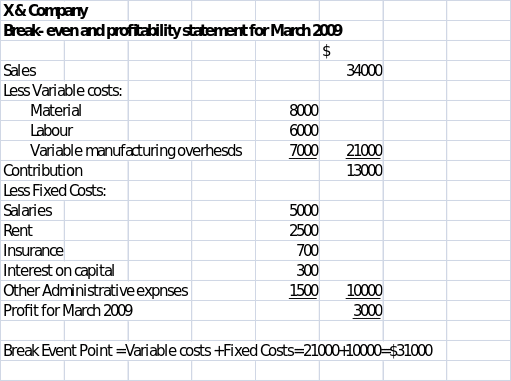Introduction
This write up contains a practical application of break even analysis of variable or marginal costing systems. The stress is on the use of contribution calculations and the importance of variable and fixed costs in the analysis.
Application and analysis
The company selected is X & Company. It is an Electric storage company manufacturing energy storage delivery systems. The company uses a marginal costing system for its cost accounting affairs. For the purpose of computing its profitability the company has defined the following for the purpose of its cost measurement:
Unit of measurement
The company works on a job basis and material, labor and other expenditures are measured on per machine basis.
Revenue per unit of the activity
Each electric storage delivery system is assembled separately as per specifications provided by the customers. Accordingly revenue of each system is easily identifiable. Total revenue of three systems assembled and sold during March 2009 was $34000.
Variable costs for the activity
Variable costs include material, labor, and manufacturing overheads. Each machinery’s material is different and accordingly vary as per size and specifications provided by the customer. So is the case with labor and manufacturing overhead costs. During March 2009 the material cost was $8000, labor $ 6000, and manufacturing overheads were $7000. It may be noted that ‘variable costs are often equal to cost of goods sold and be the only incremental costs relevant to pricing decision.’(Linda Gorchels, page 106)
Fixed Costs
‘Costs that essentially remain unchanged even though the business increases its volume of sales are fixed costs.’(Gene Siciliano, page 128). Fixed overheads include factory rent, factory insurance, office salaries and other administrative expenses. Most of these expenses are paid on a monthly basis and accordingly cannot be easily identified with machines manufactured by the company. The expenses enumerated on monthly basis are salaries $5000, rent $2500, factory insurance $700, interest on capital employed $ 3600 per annum or $300per month, and other administrative expenses comes to $1500.
Under marginal costing, also called variable costing, profitability is calculated through the method of contribution made by revenue after meeting the variable expenses on the products sold. This also helps in determining the break- even point where the company makes no profit and no losses. At the point of break even sales achieved is equal to its total cost incurred up to that point of sales. ‘The objective of break even analysis is to determine the sales volume level at which the product will generate enough revenue to start earning a profit.’ (Carlos W. Moore and Justine Gooderl, page 1917) If production is enhanced beyond this level, profit shall accrue to the business, and if it is decreased from this level, loss shall be suffered by the business. On the other hand, contribution is the difference between selling price and the variable cost. Contribution must be equal to fixed cost in order for the company to arrive at break even point.
Break even analysis is a widely used technique to study cost- volume- profit relationship. The narrower interpretation of the term break even analysis refers to a system of determination of that level of activity where total cost equals total selling price. The broader interpretation refers to that system of analysis which determines probable profit at any level of activity. On the basis of above information of X & Co. its contribution margin, break even point and profitability for the month of March 2009 are calculated as under:

Conclusion
At a sale of $ 31000 the X & Company is breaking even. At this point the company is meeting all its cost and not profits. However, sales being more than required at break even point, the company has made a profit of $3000 during March 2009. X and Company can use this information and plan the required level of assembling activities during the coming months.
References
- Linda Gorchels, The Product Manager’s Handbook, McGraw Hill Professional, 2005, page 106.
- Gene Siciliano, Finance for Non- Financial Managers, McGraw Hill Professional, 2003, page 128.
- Carlos W. Moore and Justine Gooderl, Managing Small Business, Cengage Learning EMEA, 2008, page 1917.